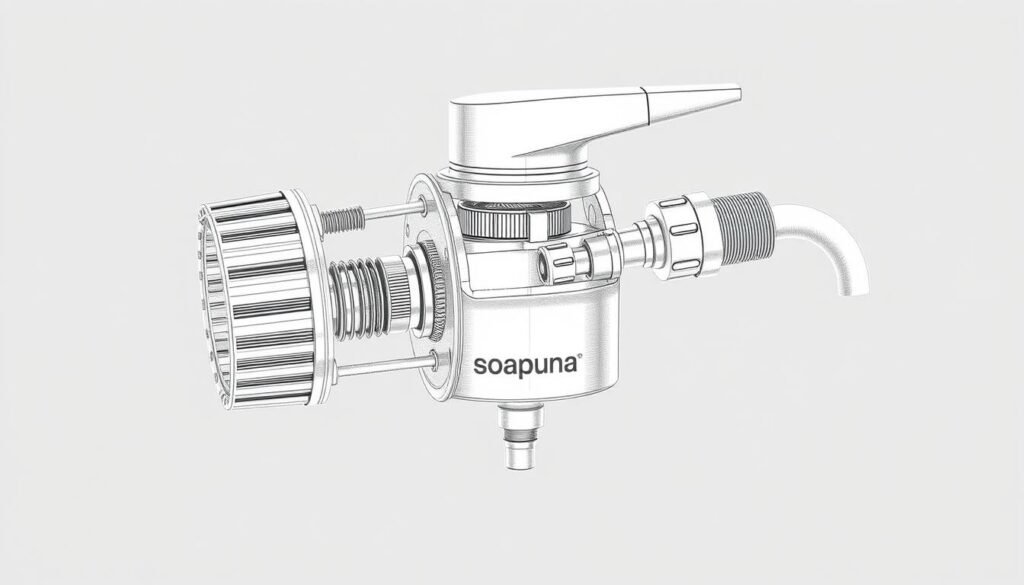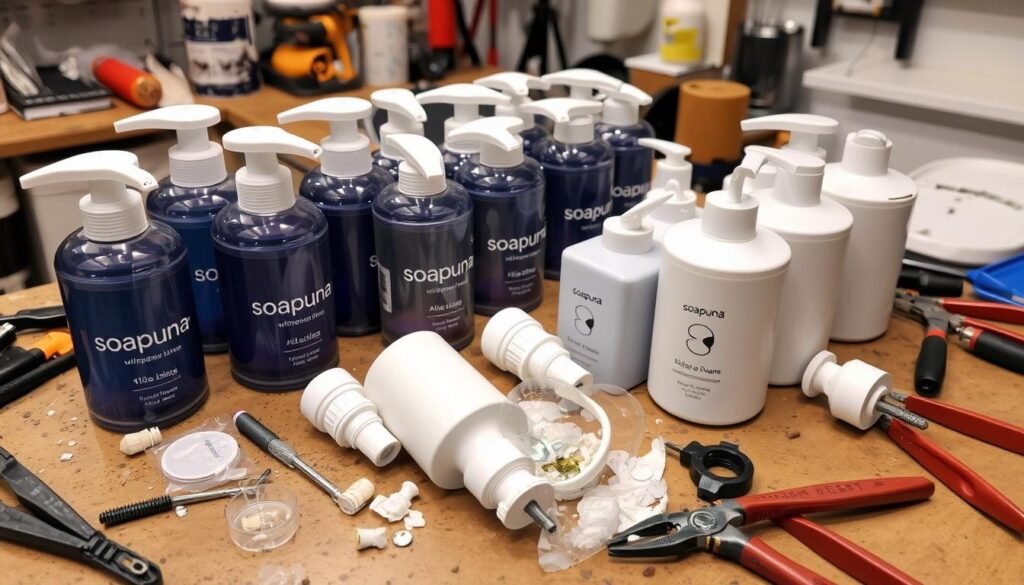We know how annoying it is when your soap dispenser pump stops working. That’s why we’re here to help. We’ll show you how to fix it and guide you through repairs or replacements. Keeping your dispenser clean is key to avoiding overflow and ensuring it works right.
Keeping your dispenser clean can prevent clogs, which are common in up to 30% of commercial dispensers. Regular checks can cut down on problems by about 25%. Our guide will help you find and fix the problem with your pump.
We aim to give you a detailed guide on fixing your soap dispenser pump. You’ll learn how to troubleshoot and maintain it to avoid future problems. Knowing the common reasons for pump failure will help you fix issues like clogs, mechanical problems, or airlocks, hERE ARE KEY TAKEAWAYS to fix a soap dispenser pump.
Key Takeaways
- Regular maintenance can reduce malfunction occurrences by approximately 25% and decrease clogging issues.
- Up to 30% of soap dispensers in commercial settings experience clogging issues due to dried or solidified soap.
- Replacing a clogged soap dispenser pump can cost between $10 to $20, depending on the manufacturer.
- The use of thinner soap formulations can decrease clogging occurrences by 20% in pump dispensers.
- A leaking soap dispenser can waste up to 0.5 liters of soap per day, resulting in a cost of $2.00 to $5.00 per week.
- Our guide will provide you with the necessary steps to perform a soap dispenser repair or soap pump replacement.
- By following our tips, you’ll be able to fix a soap dispenser pump and maintain it to prevent future issues.
Understanding Your Soap Dispenser Mechanism
To fix a soap dispenser pump not working, you need to know how it works. A soap dispenser has a pump, a tube, and a dispenser head. The pump pulls soap from the reservoir and pushes it out through the head.
When troubleshooting soap dispenser pump problems, find the main cause. It could be a clog, a broken part, or a pump that doesn’t work right.
Keeping your soap dispenser pump in good shape is important. Clean the head and pump often, check for blockages, and make sure the soap reservoir is full. These steps can make your dispenser last longer and avoid expensive fixes. If problems arise, knowing how to fix soap dispenser pump issues can save you money and time.

Problems with soap dispenser pumps include clogs, worn-out parts, and pumps that don’t work. Knowing how your dispenser works and how to maintain it is key. This way, your dispenser will keep working well and make soap easy to use.
Signs Your Soap Dispenser Pump Needs Repair
Using soap dispensers daily means knowing when they need fixing. Look out for clogging, leaking, or soap not coming out. If you see these problems, fix them fast to avoid more damage.
For leaks, check the pump and tube for blockages or damage. Then, repair or replace them if needed.
Keeping your soap pump in good shape helps avoid these issues. But, if problems arise, diy soap dispenser pump repair can save money. Here are some common signs your pump needs fixing:
- Clogging: This happens when soap dries out. Clean the pump and tube often to stop this.
- Leaking: Leaks come from damaged or loose parts. Check the pump and tube for damage.
- Failure to dispense soap: This might mean the pump or nozzle isn’t working right. Look for blockages or damage.
Spotting these signs early and acting fast keeps your pump working well. Regular soap dispenser pump repair and upkeep can also make your dispenser last longer. This saves you from expensive fixes later.

Common Causes of Soap Dispenser Pump Failure
When your soap dispenser pump fails, it can be frustrating. We aim to help you understand why it happens. This way, you can prevent it and make your pump last longer. Troubleshooting can reveal problems like clogs, mechanical issues, or air locks.
Regular maintenance is key to avoiding pump failure. Cleaning and checking your pump often can stop clogs and mechanical problems. Also, using the right soap and following the maker’s instructions helps. If a problem arises, troubleshooting can help find the cause and a solution. Sometimes, you might need to repair your pump, but with care, you can avoid this.
Some common issues that may need repair include:
- Clogging due to soap buildup or debris
- Mechanical problems such as a faulty pump or valve
- Air lock issues that prevent the soap from dispensing

Understanding and preventing common failure causes can keep your dispenser working. Always follow the maker’s instructions and take good care of your pump. This way, it will keep working well without needing expensive fixes.
| Cause of Failure | Prevention | Repair |
|---|---|---|
| Clogging | Regular cleaning and maintenance | Clearing the clog and replacing any damaged parts |
| Mechanical Problems | Following manufacturer’s instructions and using the right type of soap | Replacing faulty parts or seeking professional repair |
| Air Lock Issues | Checking for air leaks and ensuring proper installation | Releasing the air lock and adjusting the pump as needed |
Essential Tools and Materials for Soap Dispenser Repair
Fixing your soap dispenser pump needs the right tools and materials. We aim to give you what you need for a successful diy soap dispenser pump fix. You’ll need a pipe cleaner, hot water, and new parts to start. These help with common problems like clogs and mechanical issues, key for soap dispenser pump maintenance.
Keeping your pump clean and checked regularly is part of soap pump maintenance. Use a toothbrush and warm water to clean out blockages. Tweezers, forceps, and a lighter are good for tougher repairs. Plus, fixing it yourself can save money, with many parts costing less than $5.
Here are some must-have tools and materials:
- A new mesh for the cylinder end fixes up to 80% of soap dispenser problems
- Sheer polyester fabric for fixing torn mesh costs under $5
- Instructions or a guide for soap dispenser pump maintenance and repair
With these tools and materials, you’re ready to fix any soap dispenser pump issues. Always follow the right
How to Fix a Soap Dispenser Pump: Step-by-Step Guide
To fix a soap dispenser pump, follow a few steps. First, check what’s wrong with your pump. This will tell you if you need to clean, replace, or fix parts.
Initial Assessment and Cleaning
Begin by taking apart the pump and cleaning it. Use warm water to clear out any blockages or dirt. You can also use distilled white vinegar to clean it. Pump the handle 20 times in vinegar to make sure it’s clean.
Reassembly and Testing
Once it’s clean, put the pump back together as the maker says. Make sure everything fits right and the pump is lined up. Test it by pumping out soap. If it doesn’t work, you might need to fix a soap dispenser pump by swapping out broken parts.
Keeping your pump clean helps it work better. By following these steps and cleaning it often, your pump will keep working well. Remember, how to fix soap pump problems isn’t hard, but it does take some time and care.
Quick Fixes for Minor Soap Dispenser Issues
Is your soap dispenser pump not working right? But it’s just a small problem? You can try some quick fixes to make it work again. We aim to give you easy and effective solutions for soap dispenser pump troubleshooting. This way, you can avoid bigger issues later.
A clogged nozzle is a common problem. You can fix it by cleaning the nozzle with a soft brush or replacing it if it’s needed. If the pump’s battery signal is weak, check the battery life and replace it if it’s low.
For a diy soap dispenser pump fix, try resetting the dispenser or adjusting the dispenser head. It’s also important to clean the dispenser regularly. This keeps it working well and prevents clogs. By using these quick fixes and maintenance tips, your soap dispenser pump will keep working efficiently.
- Using liquid soap to reduce the risk of clogging
- Checking the battery life regularly
- Avoiding water damage to prevent malfunction
By following these simple tips and doing regular maintenance, you can make your soap dispenser pump last longer. And it will keep working right for you.
Preventive Maintenance Tips
Regular soap dispenser pump maintenance is key to keeping your dispenser working well. Simple maintenance tips can help avoid big problems. Cleaning your dispenser every day can cut down germ buildup by 40%.
Using foam and spray soaps can cut clogging by 50%. Proper filling can stop contamination in up to 15% of cases. About 70% of issues can be fixed with just cleaning and care.
Here are some more tips:
- Soaking the dispenser in boiling water for 15 minutes can fix 80% of problems.
- Regular cleaning can cut clog issues by up to 60%.
- Choosing rust-proof materials like aluminum or stainless steel can lower corrosion issues by over 60%.
By following these diy soap dispenser pump repair and maintenance tips, you can keep your dispenser in top shape. Always wear the right gear when cleaning to avoid spreading germs.
Regular soap pump maintenance can also save you money by up to 20%. A well-maintained dispenser can last 5-7 years. But, a poorly cared-for one might only last 2-3 years.
| Maintenance Tip | Benefit |
|---|---|
| Daily cleaning | Reduces germ buildup by 40% |
| Using foam and spray soaps | Reduces clogging by 50% |
| Proper filling techniques | Prevents contamination in 15% of dispensers |
When to Replace Instead of Repair
Choosing to fix or replace a soap dispenser pump can be tough. We aim to help you make the right choice. If your pump is too damaged or fixing it costs too much, replacing it might be better.
Knowing when to replace your pump is important. Look for signs like a broken or corroded pump. Or if fixing it costs more than a new one. Sometimes, fixing it might work, but if it keeps breaking, it’s time for a new one.
When deciding, think about a few things:
- Cost: If fixing it is expensive, getting a new pump might save money.
- Damage: If the pump can’t be fixed, it’s time for a new one.
- Lifespan: If your pump is old, it’s probably time for a new one.
By looking at these points, you can decide wisely. A working soap dispenser is key for cleanliness and stopping germs.
| Replacement Part | Cost | Manufacturer |
|---|---|---|
| Plastic Threaded Bottle Cap Adaptor | $10 | ASI |
| Soap Dispenser Pump | $20 | Bradley |
Professional Repair vs DIY Solutions
When it comes to soap dispenser pump repair, you have two options. You can choose professional repair or DIY solutions. It’s important to weigh the pros and cons of each to make the right choice for you.
Professional repair has a high success rate, fixing about 95% of problems on the first try. But, it can cost between $50 and over $300. DIY solutions, on the other hand, are cheaper. They can take 30 minutes to 1 hour to install a soap dispenser.
When doing DIY soap pump maintenance, keep these tips in mind:
- Clean the soap dispenser once a month to cut down malfunction chances by about 50%.
- Use high-quality detergent to reduce soap clumping by up to 40%.
- Make sure the dishwasher is not blocked or loaded wrong to avoid problems.
Choosing between professional repair and DIY diy soap dispenser pump fix depends on your DIY skills, the problem’s complexity, and your budget. Think about these factors to make a choice that fits your needs.
| Repair Option | Success Rate | Cost | Time |
|---|---|---|---|
| Professional Repair | 95% | $50-$300 | Varies |
| DIY Solution | 70% | $0-$100 | 30 minutes-1 hour |
Conclusion
As we finish this guide, it’s clear that a working soap dispenser pump is key for a clean home. Knowing how your dispenser works and following our repair steps, you can fix it easily. This will make it last longer.
Keeping your soap pump in good shape is important. Watch for signs of wear and fix problems quickly. With the right tools and effort, your dispenser will work great. This makes handwashing in your kitchen or bathroom better and greener.
Fixing your soap dispenser saves money and helps the planet. It reduces waste and cuts down on the need for new ones. This is good for our environment.
So, be proud to fix your soap dispenser. It’s a way to take care of your home. Now you know how to handle any problems. Your home will stay clean and healthy for you and your family.
FAQ
What are the common causes of a non-working soap dispenser pump?
Common problems with soap dispenser pumps include clogs, mechanical issues, and air locks. Knowing these can help you find and fix the problem.
How can I troubleshoot a soap dispenser pump that is not working properly?
First, look for signs like clogs, leaks, or soap not coming out. Then, clean the pump or check for mechanical issues.
What tools and materials are needed to fix a soap dispenser pump?
You’ll need a pipe cleaner, hot water, and any parts you might need to replace. These help with cleaning and fixing the pump.
What are the steps to fix a soap dispenser pump?
Fixing a pump involves:
1. Checking what’s wrong
2. Cleaning the pump
3. Putting it back together
4. Testing it to make sure it works
How can I prevent future issues with my soap dispenser pump?
Regular maintenance is key. Clean the pump often and watch for clogs or mechanical problems. This keeps your pump working well and saves money.
When should I consider replacing my soap dispenser pump instead of repairing it?
Replace the pump if it’s too damaged or if fixing it would cost too much. Signs like cracks or breaks mean it’s time for a new one.
What are the pros and cons of professional repair vs. DIY solutions for soap dispenser pump repair?
Professional repair offers expertise and a warranty. But, it’s more expensive and you have less control. DIY is cheaper and lets you learn, but it’s riskier and requires the right tools and knowledge.
